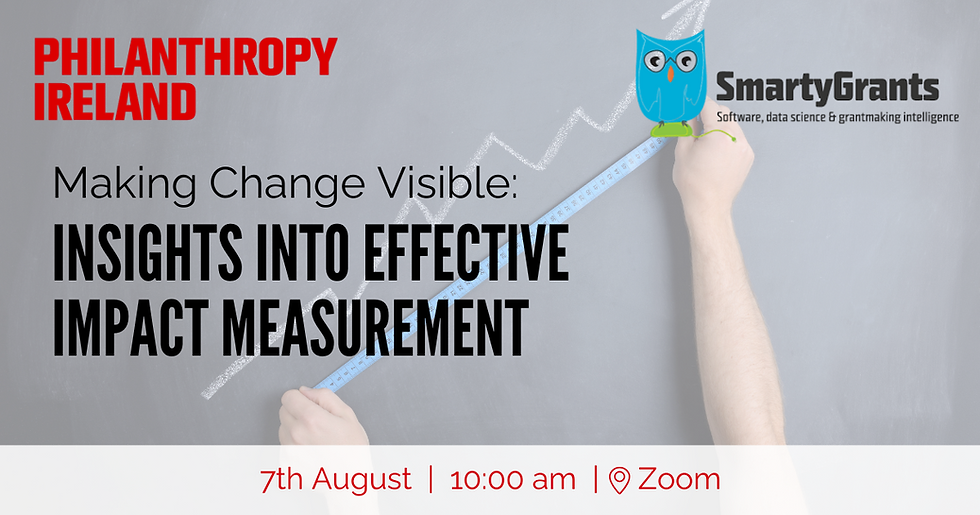An Overview of Legacy Giving in Ireland
- Sep 8, 2023
- 4 min read
Updated: Jul 14
By: Hazel Hennessy, Philanthropy Ireland
Legacy giving involves leaving a gift in your will to a charity or nonprofit. There are many ways to leave a legacy, but one thing they all have in common is the tremendous impact on the organisations who receive such a gift.
Some examples of legacy giving
Trinity’s School of Medicine was founded by a legacy from the Widow Parsons in 1711. Contemporary legacy gifts from R.B. McDowell, bequeathed a transformational legacy to the Department of History, the College Historical Society, the Trinity Library, and a scholarship to fund studentships. In 2012, the Ellen Mayston Bates bequest initiated a significant epilepsy research program aimed at aiding individuals worldwide afflicted by this condition i.
Legacy giving has made a difference in healthcare by funding medical research, equipment purchases, and improvements in healthcare facilities. A donation of €6,350 was allocated to the acute cardiology department at Mater Hospital, enabling the acquisition of two electric beds. These beds have significantly improved the quality of patient care within the acute ward, enhancing both comfort and independence enjoyed by patients during their stay ii.
The arts and cultural sector in Ireland have also been positively impacted by legacy giving. Museums, galleries, and cultural institutions have received bequests that support exhibitions, acquisitions, and preservation efforts. Henry Vaughan (1809–99) stipulated in his will that his collection of Turner watercolours should be divided among the national galleries of London, Edinburgh, and Dublin. Stating that these artworks should be displayed annually, without any admission fee, during the entire month of January. The National Gallery of Ireland continues to honour the terms of his bequest to this day iii.
2015 – 2019 The importance of legacy giving cannot be understated a report by Campaign Solutions included some very interesting data concerning legacy contributions in Ireland between 2015 and 2019 experienced remarkable growth. The data gaps are evident but the figures discussed below begin to paint a picture of the legacy income landscape in Ireland.
€234 million in legacy income was recorded during 2015 and 2019.
Legacy income witnessed a substantial rise, climbing from €30.5 million in 2015 to €49.1 million in 2019, marking a substantial 61% increase.
Campaign Solutions found 116 charities have confirmed to have received bequest income between 2015 to 2019.
Ten charities consistently received over 60% of all recorded legacy income each year, with the peak reaching 75.4% in 2017.
Environmental charities received a minimal share, constituting just 0.15% of the total legacy income over the five-year span, resulting in an annual average of slightly over €70,000 for those identified iv.
This peak in 2017 can be attributed to a once off bequeath of €30 million from Elizabeth O’Kelly to five charities – €6 million each to the Irish Cancer Society, Irish Heart Foundation, Irish Kidney Association, the Irish Society for Autism and the Royal National Lifeboat Institution v and two other two bequests exceeding €1 million from other sources vi.
2020 Estimates suggests that the cumulative legacy income for the Republic of Ireland in 2020 reached approximately €61.13 million. Additionally, the average amount obtained per charity has shown growth, rising from €312,530 in 2015 to €426,829 by 2020 vii. Further data from 2020 research reaffirms that most legacies were unrestricted, offering vital support for addressing immediate needs or specific projects that may lack immediate funding.
Approximately 91.7% of legacies were unrestricted, while 8.3% were categorized as restricted viii. 2021 and Formalised Reporting
€94,718,450 was reported in charity bequests, accounting for 3.3% of charity income according to the Charity Regulator’s new report on Charitable Bequests. 2021 is a watershed moment for data reporting as charities are now required to specify the amount of income from bequests.
This data was derived from the analysis of 6,007 annual reports for the year 2021, all of which were filed by February 2023.
It is worth noting that nearly one-fifth of registered charities had not yet filed their annual reports at the time of data extraction, suggesting that the overall sum of bequests is likely higher than what is reflected in the report.
Out of the 411 charities that submitted reports, bequest income accounted for 3.3% of their total income.
The majority of these charities, about two-thirds, reported bequest amounts below €100,000, with approximately 25% reporting figures below €5,000.
On the other end of the scale, 24 respondents disclosed bequest incomes surpassing €100,000 and two charities reported amounts exceeding €500,000.
The highest individual bequest amount reported by a single charity was €9,623,000 ix.
Data is crucial in bequest and legacy giving because it provides the foundation for informed decision-making and effective strategies. Gaps exists and needs are changing. By collecting and analysing data on donor demographics, preferences, and behaviour, charities can tailor their outreach efforts, targeting the right individuals with the right messages at the right time. This not only increases the likelihood of securing bequests but also helps in cultivating long-term relationships with potential donors. In our 2024 Budget Submission Philanthropy Ireland has called on the Government to invest in data collection which will allow organisations and donors to track the performance of their legacy giving programs, enabling them to adapt and refine their approaches based on real-time insights. Ultimately, data empowers charities and philanthropists to maximize their impact. In the end legacy giving holds the remarkable power to transcend one’s lifetime, leaving an enduring impact on causes and organizations that align with their values and passions. By including charitable bequests in their estate plans, individuals can extend their influence, fostering a culture of altruism that ripples through time, providing crucial support to charitable endeavors, educational institutions, and philanthropic missions. Inspiring future generations to continue the legacy of giving.





Comments